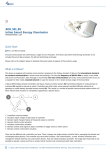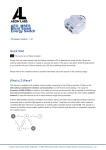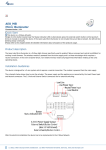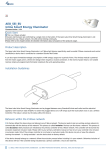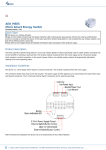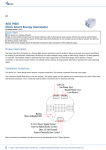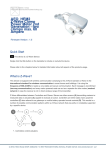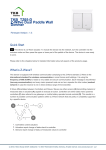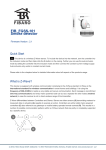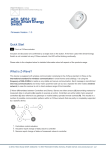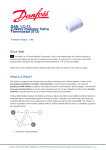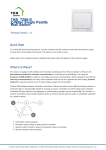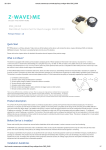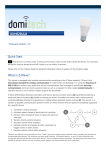Download AEO_MEI Micro Illuminator
Transcript
AEO_MEI Micro Illuminator Firmware Version : 1.24 Quick Start A This device is a Z-Wave Actuator. Single click the button located near the Status Indication LED or alternatively press the external switch/ button control quickly 6 times to include or exclude the device. If the Aeon Labs Micro Illuminator is not included into any Z-Wave network, the LED will be blinking slowly continually. Please refer to the chapters below for detailed information about all aspects of the products usage. What is Z-Wave? This device is equipped with wireless communication complying to the Z-Wave standard. Z-Wave is the international standard for wireless communication in smart homes and buildings. It is using the frequency of 868.42 MHz to realize a very stable and secure communication. Each message is reconfirmed (two-way communication) and every mains powered node can act as a repeater for other nodes (meshed network) in case the receiver is not in direct wireless range of the transmitter. Z-Wave differentiates between Controllers and Slaves. Slaves are either sensors (S) transmitting metered or measured data or actuators (A) capable to execute an action. Controllers are either static mains powered controllers (C) also referred to as gateways or mobile battery operated remote controls (R). This results in a number of possible communication patterns within a ZWave network that are partly or completely supported by a specific device. 1. 2. 3. 4. 5. 6. 7. Controllers control actuators Actuators report change of status back to controller Sensors report change of status of measured values to controller Sensors directly control actuators Actuators control other actuators Remote controls send signals to static controllers to trigger scenes or other actions Remote controls control other actuators. There are two different role a controller can have. There is always one single primary controller that is managing the network and including/excluding devices. The controller may have other functions - like control buttons - as well. All other controllers don't manage the network itself but can control other devices. They are called secondary controllers. The image also shows that its not 1 (c) 2012 Z-Wave Europe GmbH, Goldbachstr. 13, 09337 Hohenstein-Ernstthal, Germany, www.zwaveeurope.com possible to operate a sensor just from a remote control. Sensors only communicate with static controllers. Product description The Aeon Labs Micro Illuminator is a Z-Wave light dimmer specifically used to enable Z-Wave command and control (on/off/dim) for existing in-wall dimmers. The wireless module is powered from the mains supply and is a three-wire design which requires a neutral connection. In the event of power failure, non-volatile memory retains all programmed information relating to the units operating status. Before Device is installed Please read carefully the enclosed user manual before installation of the radio-actuator, in order to ensure an error-free functioning. ATTENTION: only authorized technicians under consideration of the country-specific installation guidelines/norms may do works with 230 Volt mains power. Prior to the assembly of the product, the voltage network has to be switched off and ensured against re-switching. The product is permitted only for proper use as specified in the user manual. Any kind of guarantee claim has to be forfeited if changes, modifications or painting are undertaken. The product must be checked for damages immediately after unpacking. In the case of damages, the product must not be operated in any case. If a danger-free operation of the equipment cannot be assured, the voltage supply has to be interrupted immediately and the equipment has to be protected from unintended operation. Installation Guidelines The device is designed for a 3 wire system which requires a neutral connection. The module is powered from the main supply. The schematic below shows how to wire the actuator. The power supply and the appliance are connected by the Load, Power Input and Neutral connectors. The 3.3 Volt and External Switch connectors are for external switching. After the electrical installation the device has to be implemented in the Z-Wave Network. 2 (c) 2012 Z-Wave Europe GmbH, Goldbachstr. 13, 09337 Hohenstein-Ernstthal, Germany, www.zwaveeurope.com Behavior within the Z-Wave network I On factory default the device does not belong to any Z-Wave network. The device needs to join an existing wireless network to communicate with the devices of this network. This process is called Inclusion. Devices can also leave a network. This process is called Exclusion. Both processes are initiated by the primary controller of the Z-Wave network. This controller will be turned into exclusion respective inclusion mode. Please refer to your primary controllers manual on how to turn your controller into inclusion or exclusion mode. Only if the primary controller is in inclusion or exclusion mode, this device can join or leave the network. Leaving the network - i.e. being excluded - sets the device back to factory default. If the device already belongs to a network, follow the exclusion process before including it in your network. Otherwise inclusion of this device will fail. If the controller being included was a primary controller, it has to be reset first. To include the Aeon Labs Micro Illuminator with your Z-Wave controller simple bring it in the inclusion-mode and click the Inclusion/Exclusion button at the Aeon Labs Micro Illuminator once. Alternatively you can use the external switch by quickly pressing it six times. If the Aeon Labs Micro Illuminator was successfully included to a Z-Wave network, the Status Indication LED will either be solid on or off (depending on if the switch is on or off) 10 seconds after the button was last pressed. Operating the device The dimmer is operated by an external switch/button or wireless. The click on the switch sets the dimmer on or off. To have the dimming function simple hold the button pushed until your desired level. The dimmer insert memorizes the last lighting level and switches automatically to the same level. Node Information Frame NIF The Node Information Frame is the business card of a Z-Wave device. It contains information about the device type and the technical capabilities. The inclusion and exclusion of the device is confirmed by sending out a Node Information Frame. Beside this it may be needed for certain network operations to send out a Node Information Frame. A single click at the Inclusion/Exclusion switch sends a Node Information Frame. LED Control ● ● The LED on the Micro Illuminator will blink if it is currently not paired into a Z-Wave network. If the Aeon Labs Micro Illuminator was successfully included to a Z-Wave network, the Status Indication LED will either be solid on or off (depending on if the switch is on or off) 10 seconds after the button was pressed. Associations A Z-Wave devices control other Z-Wave devices. The relationship between one device controlling another device is called association. In order to control a different device, the controlling device needs to maintain a list of devices that will receive controlling commands. These lists are called association groups and they are always related to certain events (e.g. button pressed, sensor triggers, ...). In case the event happens all devices stored in the respective association group will receive a common wireless command. Association Groups: 1 Status Reports (max. nodes in group: 5) Configuration Parameters Z-Wave products are supposed to work out of the box after inclusion, however certain configuration can adapt the function better to user needs or unlock further enhanced features. IMPORTANT: Controllers may only allow configuring signed values. In order to set values in the range 128 … 255 the value sent in 3 (c) 2012 Z-Wave Europe GmbH, Goldbachstr. 13, 09337 Hohenstein-Ernstthal, Germany, www.zwaveeurope.com the application shall be the desired value minus 256. For example: to set a parameter to 200 it may be needed to set a value of 200 minus 256 = minus 56. In case of a two byte value the same logic applies: Values greater than 32768 may needed to be given as negative values too. Type of Sensor Report (Parameter Number 1, Parameter Size 1) Defines the value type to be sent as Sensor Report. Value Description 0 Power (Default) 1 Voltage Blinking Behavior (Parameter Number 2, Parameter Size 2) This is a double byte value. The LSB defines the total time the device need to blink. The value if set in seconds. The MSB defines the on/off interval of the blinking. The unit is 0.1 s. Value Description 0 — 65535 Configuration Bytes (Default 0) Notification on Status Change (Parameter Number 80, Parameter Size 1) Defines the automated status notification of an associated device when status changes Value Description 0 Deactivated (Default) 1 Hail sent 2 BASIC Report Sent Disables Function of automated sending of a Report triggered by minimal change of value. (Parameter Number 90, Parameter Size 1) Value Description 0 Disabled (Default) 1 Enabled Minimum Change to send Report (Watt) (Parameter Number 91, Parameter Size 2) The value represents the minimum change in Wattage for a Report to be sent . Value Description 0 — 32000 W (Default 50) Minimum Change to send Report (%) (Parameter Number 92, Parameter Size 1) The value represents the minimum change in Watage Percent for a report to be sent Value Description 0 — 255 % (Default 10) Report type send in Reporting Group 1 (Parameter Number 101, Parameter Size 4) Defines the type of report sent for the Reporting Group 1. 4 (c) 2012 Z-Wave Europe GmbH, Goldbachstr. 13, 09337 Hohenstein-Ernstthal, Germany, www.zwaveeurope.com Value Description 2 MultiSensor Report 4 Meter Report for Watt 8 Meter Report for kWh (Default) Report Type send in Reporting Group 2 (Parameter Number 102, Parameter Size 4) Defines the type of report sent for the Reporting Group 2. Value Description 2 MultiSensor Report 4 Meter Report for Watt 8 Meter Report for kWh Report Type send in Reporting Group 3 (Parameter Number 103, Parameter Size 4) Defines the type of report sent for the Reporting Group 3. Value Description 2 MultiSensor Report 4 Meter Report for Watt 8 Meter Report for kWh Send Interval for Reporting Group 1 (Parameter Number 111, Parameter Size 4) Defines the time interval when the defined report of Reporting Group 1 is sent out. Value Description 0 — 65535 Interval (Default 720) Send Interval for Reporting Group 2 (Parameter Number 112, Parameter Size 4) Defines the time interval when the defined report of Reporting Group 2 is sent out. Value Description 0 — 65535 Interval (Default 720) Send Interval for Reporting Group 3 (Parameter Number 113, Parameter Size 4) Defines the time interval when the defined report of Reporting Group 3 is sent out. Value Description 0 — 32000 Interval Command Classes Supported Command Classes 5 (c) 2012 Z-Wave Europe GmbH, Goldbachstr. 13, 09337 Hohenstein-Ernstthal, Germany, www.zwaveeurope.com ● ● ● ● ● ● ● ● ● Basic (version 1) Association (version 1) Multilevel Switch (version 1) All Switch (version 1) Meter (version 2) Configuration (version 1) Multilevel Sensor (version 3) Manufacturer Specific (version 1) Version (version 1) Technical Data Explorer Frame Support No SDK 5.02 pl3 Device Type Slave with routing capabilities Generic Device Class Multilevel Switch Specific Device Class Multilevel Power Switch Routing Yes FLiRS No Firmware Version 1.24 Explanation of Z-Wave specific terms ● ● ● ● ● ● ● ● Controller — is a Z-Wave device with capabilities to manage the network. Controllers are typically Gateways, Remote Controls or battery operated wall controllers. Slave — is a Z-Wave device without capabilities to manage the network. Slaves can be sensors, actuators and even remote controls. Primary Controller — is the central organizer of the network. It must be a controller. There can be only one primary controller in a Z-Wave network. Inclusion — is the process of bringing new Z-Wave devices into a network. Exclusion — is the process of removing Z-Wave devices from the network. Association — is a control relationship between a controlling device and a controlled device. Wakeup Notification — is a special wireless message issued by a Z-Wave device to announces that is able to communicate. Node Information Frame — is a special wireless message issued by a Z-Wave device to announce its capabilities and functions. Disposal Guidelines The product does not contain hazardous chemicals. Do not dispose of electrical appliances as unsorted municipal waste, use separate collection facilities. Contact your local government for information regarding the collection systems available. If electrical appliances are disposed of in landfills or dumps, hazardous substances can leak into the groundwater and get into the food chain, damaging your health and well-being. 6 (c) 2012 Z-Wave Europe GmbH, Goldbachstr. 13, 09337 Hohenstein-Ernstthal, Germany, www.zwaveeurope.com






